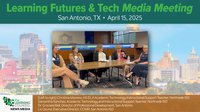Schools and districts across the country are seeing a growing demand for career and technical education (CTE). CTE is such an important and beneficial way for students to become career ready. It can also help address the growing need to fill critical skilled roles in the United States, which is projected to have a deficit of 6 million workers by 2032, according to ACTE.
While the importance of CTE is recognized, schools and districts still face challenges when creating successful CTE programs. Some of the biggest challenges are teacher shortages and recruitment, developing students’ career skills, and offering comprehensive CTE programs that meet the needs of the community. If districts prioritize these three areas, they are sure to have successful CTE programs.
Investing in CTE Teachers
Staffing shortages are not new in education, and CTE programs are no exception. One unique opportunity in CTE is to recruit industry professionals to teach CTE courses. In fact, before going into teaching, about 65.5% of public CTE teachers worked in the private sector, and about 38% of public CTE instructors entered the classroom through an alternative certification program.
Since many CTE teachers are not coming from an education background, it is essential for districts to invest in their professional development. Districts should offer up-to-date training aligned with current industry trends, as well as provide comprehensive, ready-to-use curriculum resources aligned with industry standards. Mentorship programs are also a valuable tool for new teachers. Pairing experienced educators with CTE newcomers helps build confidence, strengthen instruction, and sets teachers up for success.
Preparing Career-Ready Students
According to both teachers and district leaders in a 2024 survey conducted by Catapult X, work ethic ranks as the most challenging skill to develop in students, followed by critical thinking and communication. These skills are important for academic success, as well as for long-term career readiness, however many educators continue to struggle with how to effectively incorporate them in traditional classroom settings.
CTE offers a powerful solution by integrating hands-on learning with real-world applications and creating an environment where students are expected to take initiative and solve problems. Whether they’re designing a product, managing a project, or presenting their ideas to peers and industry partners, students in CTE courses are consistently required to demonstrate strong work habits, think independently, and communicate clearly.
For example, in a principles of construction course, students are expected to show up on time, manage deadlines, and work as part of a team to complete a project mirroring the expectations of a professional job site. In a health science program, students practice patient communication and ethical decision-making in simulated clinical settings. These immersive experiences teach technical skills as well as build the personal and professional skillsets that are increasingly demanded by employers across every field.
In addition to the skills gained in CTE classes, students can earn industry-recognized certifications within their chosen pathways. Certifications are another unique opportunity to enhance career readiness and boost employability. By preparing for and earning certifications, students expand their skillsets while demonstrating initiative and determination. Whether they plan to attend college, go into the workforce, or explore a trade, certifications help students become more well-rounded and ready for their future.
Serving the Community and Students Through CTE
Aligning CTE programming with community needs is a great way to solve two problems. It allows districts to support local businesses by building a future pool of workers to fill high-demand jobs such as those in health sciences, engineering, construction, and manufacturing thus keeping talent locally and it helps ensure that the skills students gain are directly applicable to opportunities in their own communities, making the transition from classroom to career more seamless.
Districts can also work with local businesses to provide students with industry internships and work-based learning opportunities, as well as to support their CTE programs by providing guidance on programming, donating or lending equipment, and offering space for hands-on classes. These partnerships help strengthen the connection between education and workforce development.
Impact of CTE Programs
By creating effective CTE programs, districts are equipping students with the skills they need to thrive professionally. Research shows students who complete two or more courses in a single CTE pathway are 5% more likely to be employed full time and are 4% less likely to be working part time or unemployed eight years after graduating from high school.
When districts invest in CTE teachers, provide students with abundant opportunities, and work with community business leaders they will have successful CTE programs that allow students to challenge themselves as they learn the most valuable skills for their future.
About the author
Dusty Moore is the CEO of iCEV, a leading producer of Career & Technical Education (CTE) curriculum, industry certification preparation and testing, and CTE data management.











